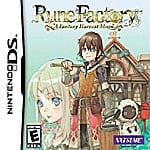Swords and Plowshares
It’s been a full decade since the first Harvest Moon game saw the light of day, and Natsume continues to churn out new variations on the much-loved farm simulator series. Since the beginning, Harvest Moon has always been about growing crops, making friends, raising livestock, upgrading your farm and tools, and seeking the affections of a potential spouse.

All of these tried and true activities remain intact in Rune Factory: A Fantasy Harvest Moon, but this refreshing addition to the series offers an unexpected twist by immersing players in realm of magic, monsters, and swordsmanship. The game expertly straddles the line between agricultural sim and traditional fantasy RPG, mixing the best elements of both to create what is easily the best Harvest Moon title on a handheld system to date.
Essentially, Rune Factory combines two games in one. The traditional emphasis on farming and gardening, and interacting with people in the town, is enough to keep players occupied for many hours. This portion alone feels like a complete Harvest Moon game. The addition of fantasy elements seems like icing on the cake. Exploring the many dungeon caves along the outskirts of town – which involves battling and taming monsters, mining for treasure, planting cave crops, and boss battle encounters – is an entirely consuming pursuit in itself. Cooking, fishing, getting married, item crafting, improving your house, researching magic, and interacting with a slew of different townspeople are just a few of the other pursuits possible in the game. Simply put, there’s a hell of a lot to keep occupied with, and transitioning back and forth between the old and new aspects of the game is seamless.
As Raguna, a young boy suffering from amnesia, players stagger into the outskirts of the town of Kardia. Parched, exhausted, and aimless, you meet a strange girl named Mist who kindly provides you with a hoe, a watering can, some seeds, and parcel of land in return for working on her farm. She suggests growing crops might trigger bits of your lost memory, and it’s not long before you agreeably settle into a routine on the farm. Word of your arrival quickly spreads to others in the village eager to make your acquaintance, ten of which are maidens which you may court. After the brief story introduction, players are left to their own devices to explore the land, grow their farm, and uncover their hidden past.

The town of Kardia is quite large, offering many different shops, personalities, and services, and it contains a great deal more charm than past handheld games in the series. There is also much exploring to be done in the caves and regions outside of the town, but you can’t just wander into these dangerous locales haphazardly. Players must obtain various passes from the mayor before being allowed to enter the different creature-filled dungeons. Passes are earned by proving your worth, and the first is obtained by giving a certain level of attention to tending your fields. You will need to spend time on the farm before growing strong enough, and gaining enough money to pick up a decent weapon at the local blacksmith’s shop, to venture on excursions into the first dungeon cave.

Back at the farm, growing crops has never been easier, as several key improvements to the gardening interface make a world of difference. Players can now walk effortlessly over crops, making watering and harvesting a breeze. A selection box – implemented in much the same way as in the two Game Cube Harvest Moon titles – can be switched off and on to allow better aim control. A sprint feature lets players dash around the garden, saving precious seconds of daylight. For each second that passes in real time amounts to a full 10 minutes in the game. All of the minor changes really make gardening less of a pain. An interesting new crop leveling-up system allows you to improve the value of your veggies and make some serious money. The rest of the farming formula remains largely untouched, as it makes sense not to mess around too much with a good thing. Raising animals on your farm is also the same in terms of gameplay, but instead of chickens and cows you will be taming and raising creatures to gather Cockadoodle eggs, Buffamo milk, and other sellable resources from a range of strange beasts. Some creatures can also be taught to work on the farm, replacing the Harvest Sprites from earlier games.
